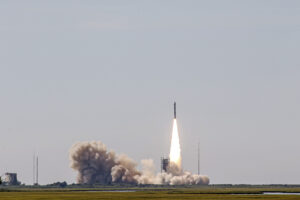“Some of the small launch providers ran into technical challenges during the development of their systems and that has delayed missions into 2021,” said Lt. Col. Ryan Rose, chief of the small launch and targets division of the Space and Missile Systems Center’s launch enterprise.
“COVID-19 also had an impact on the execution of these missions,” Rose told SpaceNews in an interview from Kirtland Air Force Base, New Mexico.
Rose runs the Space Force office that procures small-satellite launch services for military and civilian government agencies. Both the Space Force’s and NASA’s small launch programs will be taking on important roles in a crowded market where dozens of companies are developing small launch vehicles and need to secure government contracts to stay competitive.
Rose said the Space Force plans to evaluate as many emerging providers as possible and figure out how to contract for their services to meet a still uncertain future demand.
Small-satellite national security launches had a tough 2020, when only one mission flew — a Northrop Grumman Minotaur 4 classified launch for the National Reconnaissance Office that lifted off in July from NASA’s Wallops Flight Facility in Virginia. The solid-propellant four-stage Minotaur is made with three government-furnished solid-rocket motors from decommissioned intercontinental ballistic missiles.
One Space Force launch that had been planned for 2020 but didn’t happen is the Space Test Program STP-27RM mission scheduled to fly on Rocket Lab’s Electron rocket.
The mission dubbed Monolith is an Air Force Research Laboratory experiment to test the ability of small satellites to support large aperture payloads to monitor space weather. The launch has been delayed not by vehicle issues but by the longer-than-expected certification of Rocket Lab’s new launch pad at Wallops, Virginia. NASA has yet to sign off on the vehicle’s autonomous flight abort system
Rose said the Space Force is targeting a spring or summer launch. “We’ve been working with NASA on a launch opportunity,” she said.
Another Air Force Research Laboratory experiment that had been scheduled for 2020 is a sounding rocket mission also from Wallops on a new vehicle built by Space Vector and Kratos. This is an AFRL experiment to collect data during the vehicle’s suborbital flight.
The sounding rocket mission is now projected to fly in the spring, said Rose.
Two Virgin Orbit launches planned
Two other Space Force launches that slid into 2021 are Space Test Program missions awarded to Virgin Orbit, a sister company to Richard Branson’s space venture Virgin Galactic. The company intends to deploy satellites using rockets released from under the wing of a Boeing 747 airliner.
Virgin Orbit’s LauncherOne has yet to reach orbit. The company’s first attempt failed in May when the rocket’s first-stage engine shut down a few seconds after ignition. Another test flight was planned for late 2020 but the company had to stand down temporarily to allow employees “precautionary quarantines” amid the pandemic, Virgin Orbit said. A new launch attempt could happen this month at the Mojave spaceport in California.
One of Virgin Orbit’s Space Force contracts is to launch the STP-27VP mission from the the island of Guam in the Western Pacific. A second Virgin Orbit Space Force mission planned for 2021 is STP-S28, also from Guam.
Rose said the target for STP-27VP is summer and STP-S28 later in the year.
Another Minotaur launch for the National Reconnaissance Office, NROL-111, is planned for this summer from Wallops. This is the second of three missions the Space Force procured from Northrop Grumman for the NRO. The first was NROL-129 launched in 2020. A third one, NROL-174, has not yet been scheduled.
Rose said the Space Force is looking to launch other Space Test Program payloads using emerging small launch providers but that will depend on the status of newly developed vehicles. “We’ll announce this when we’re ready,” she said.
The Space Force also intends to sponsor a “tactically responsive launch” demonstration with a small rocket provider some time in 2021. The Space and Missile Systems Center is “pushing industry to demonstrate responsive launch requirements,” said Rose. That means a provider has to show it can launch a payload within months of a contract award.
Responsive launch is a Space Force priority but the details of how these services will be procured have yet to be worked out, Rose said. It’s a more complex service than just providing a rocket, she added. “You need to make sure the satellite is ready, that there’s a ground system that can support it, it’s the entire logistics package.”
Congress in the 2021 defense spending bill added $15 million for tactically responsive launch even though the Pentagon did not request any money for the program.
Rose said she could not predict if or when any of the new small launchers will be ready to fly, and said the Space Force wants to work with as many providers as possible.
Her office in October 2019 selected several small launch providers to compete for task orders over nine years. That list includes providers that have not yet flown orbital missions, including Virgin Orbit, Xbow Launch Systems, Firefly Aerospace and Aevum Launch. More companies are expected to be added to the list in the near future.
“Our customers are building more small sats,” Rose said. “We’re trying to make sure we have contract vehicles available to satisfy those requirements. It’s hard to say how many providers we’ll need.”



